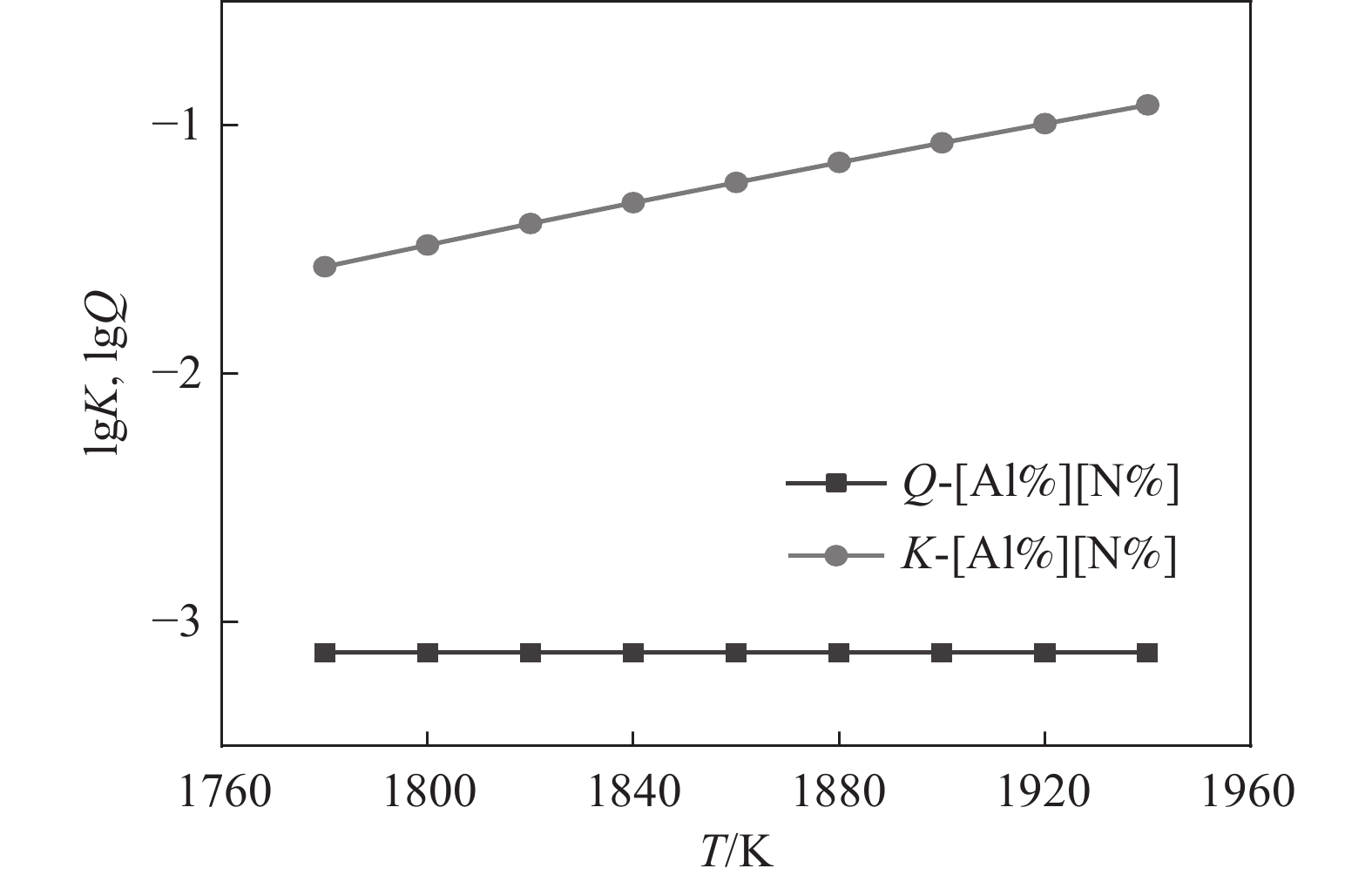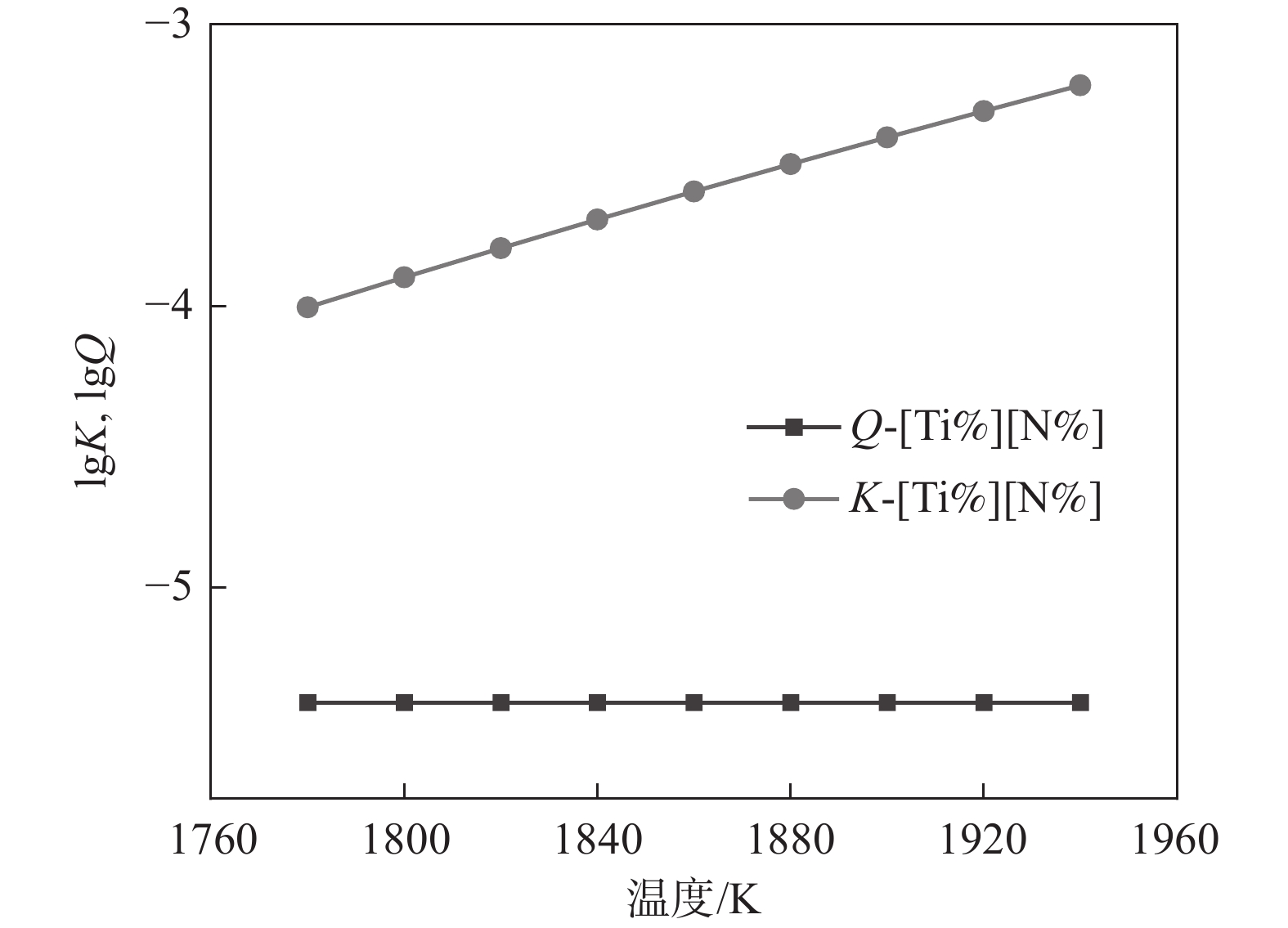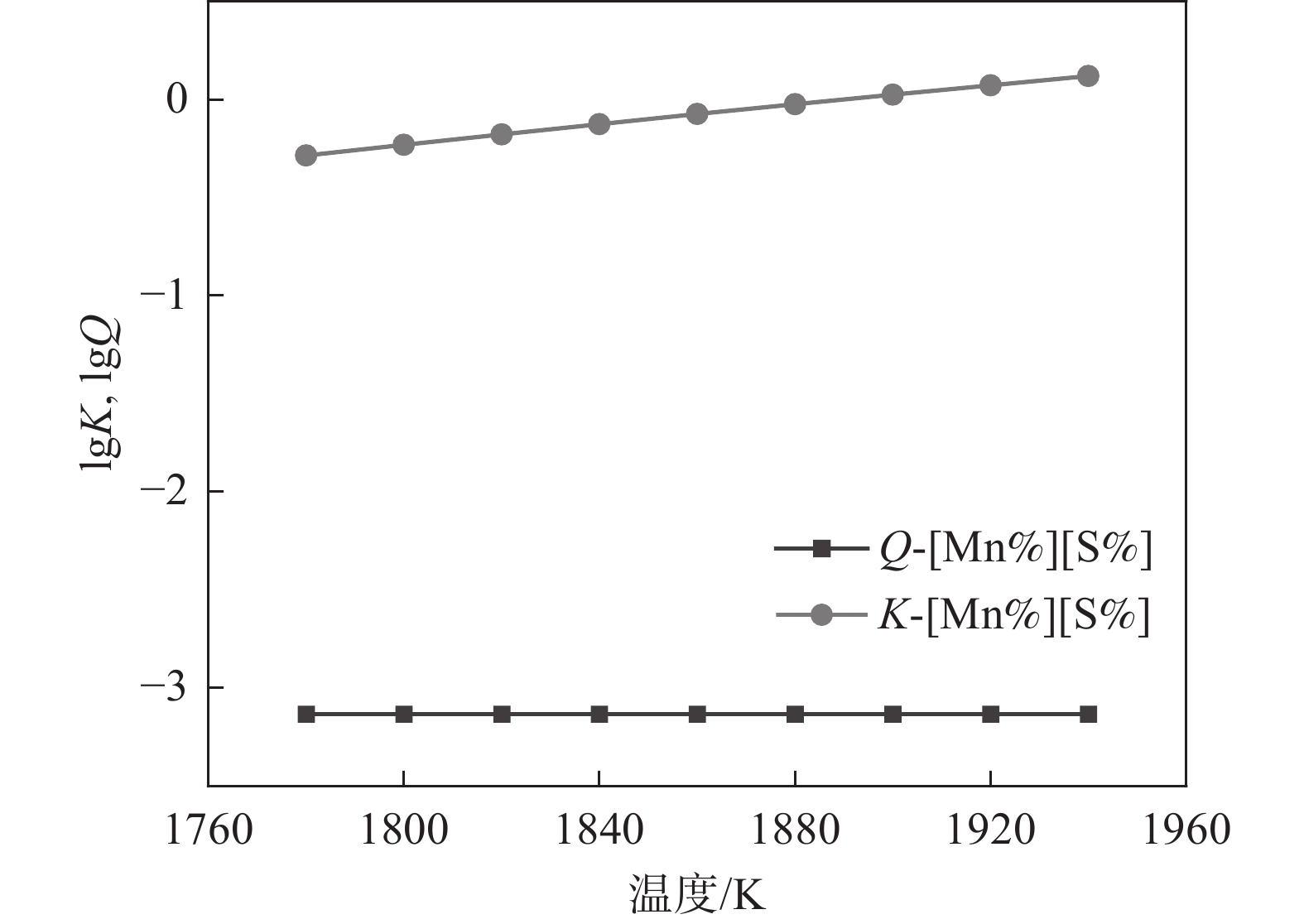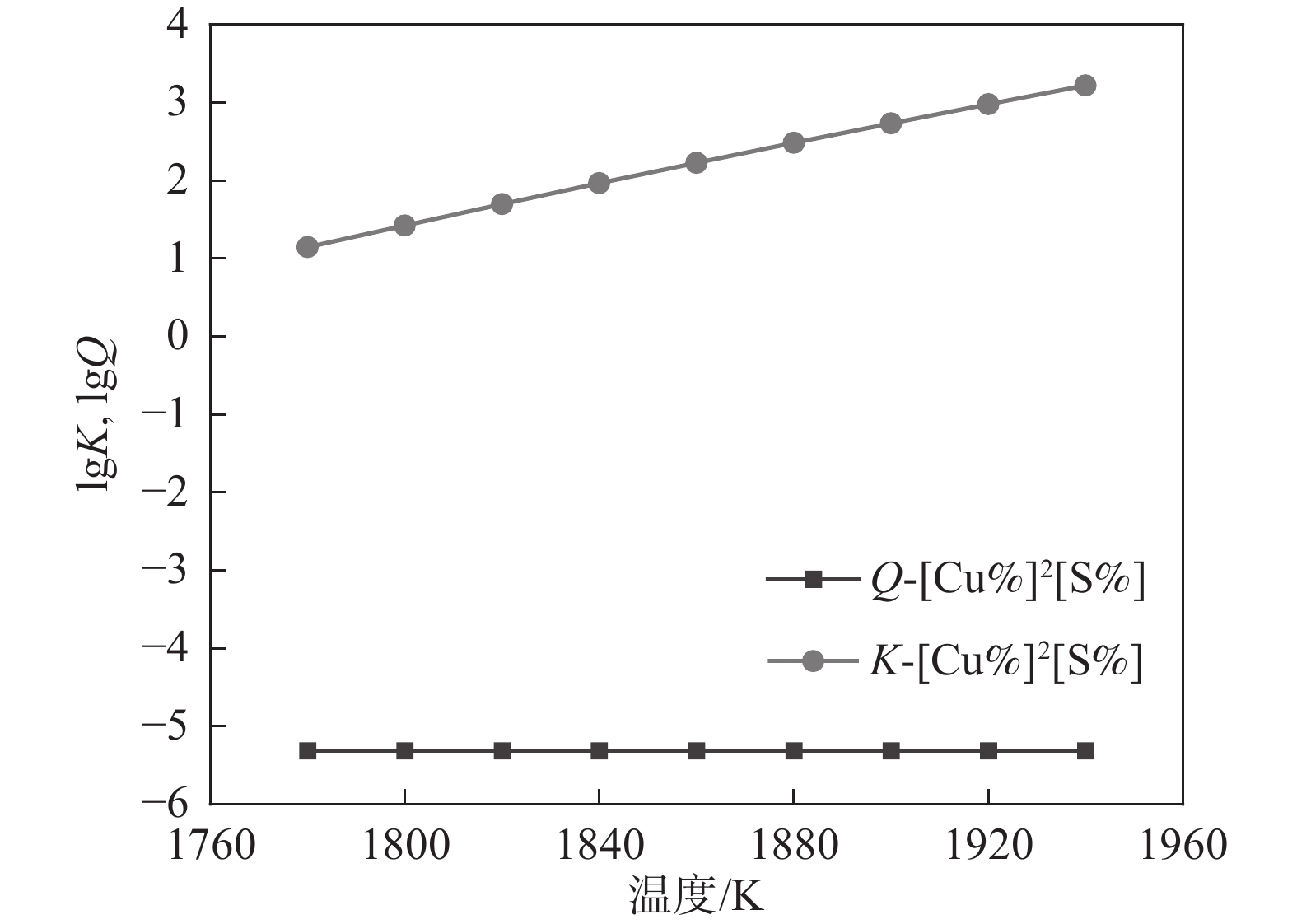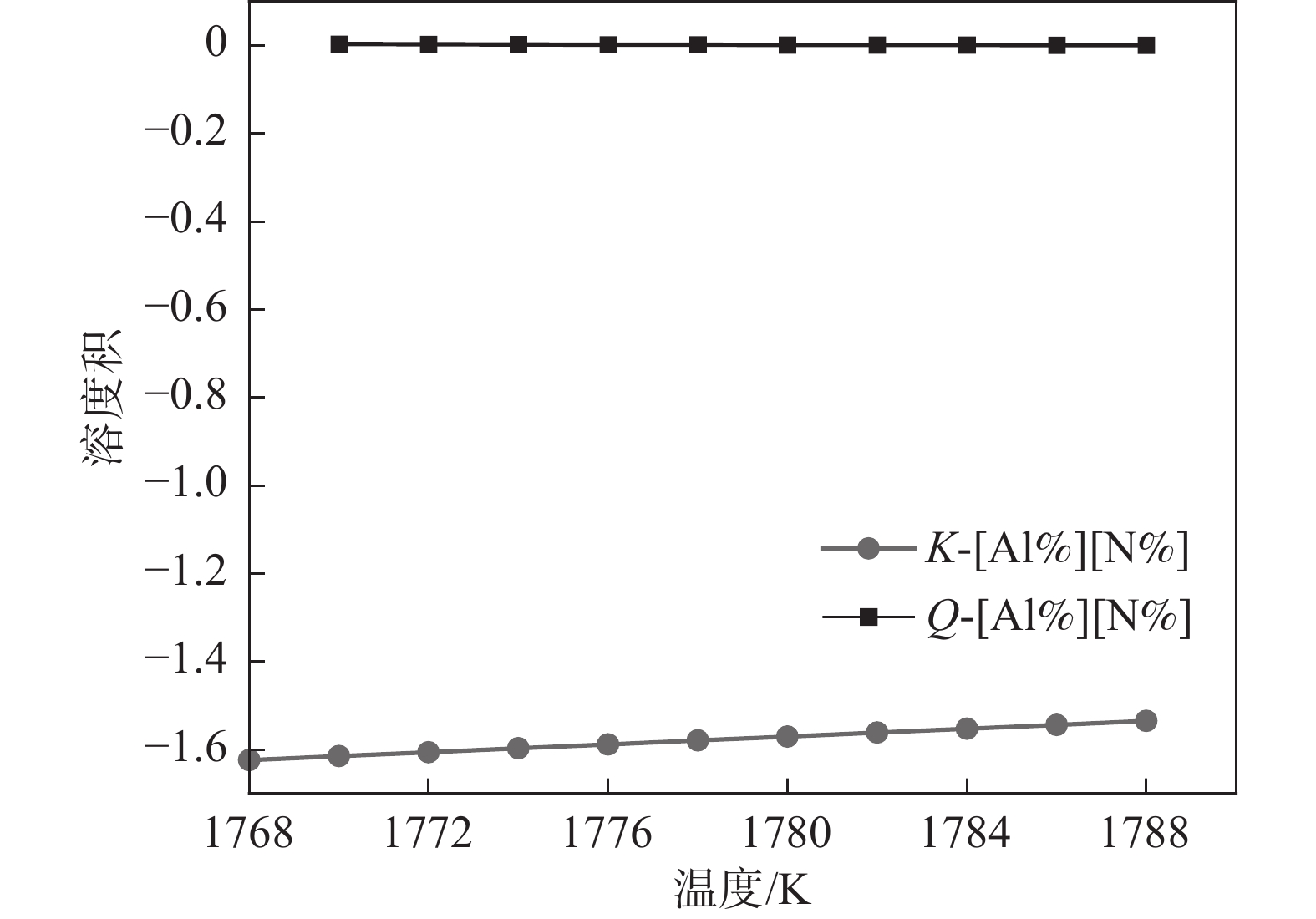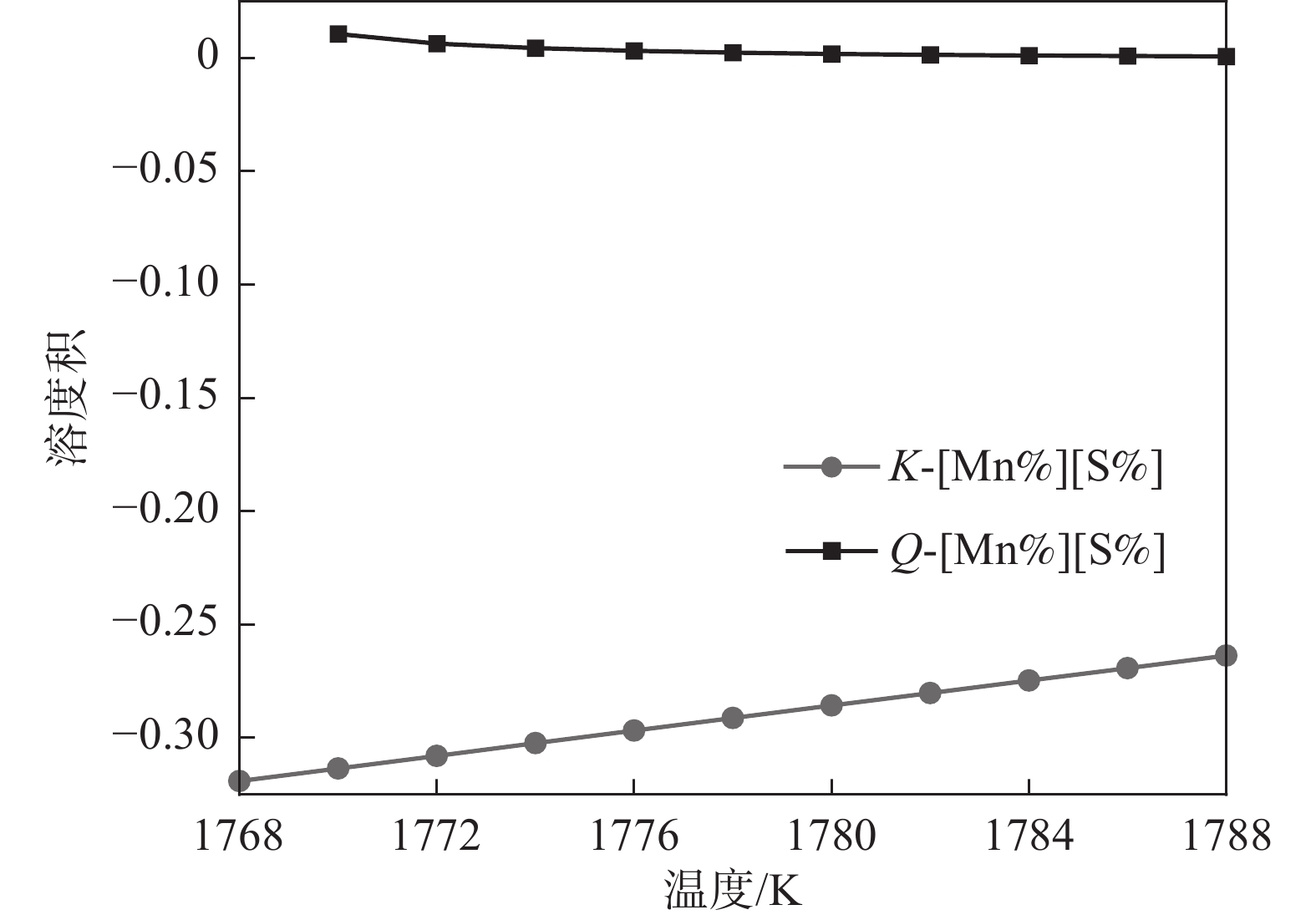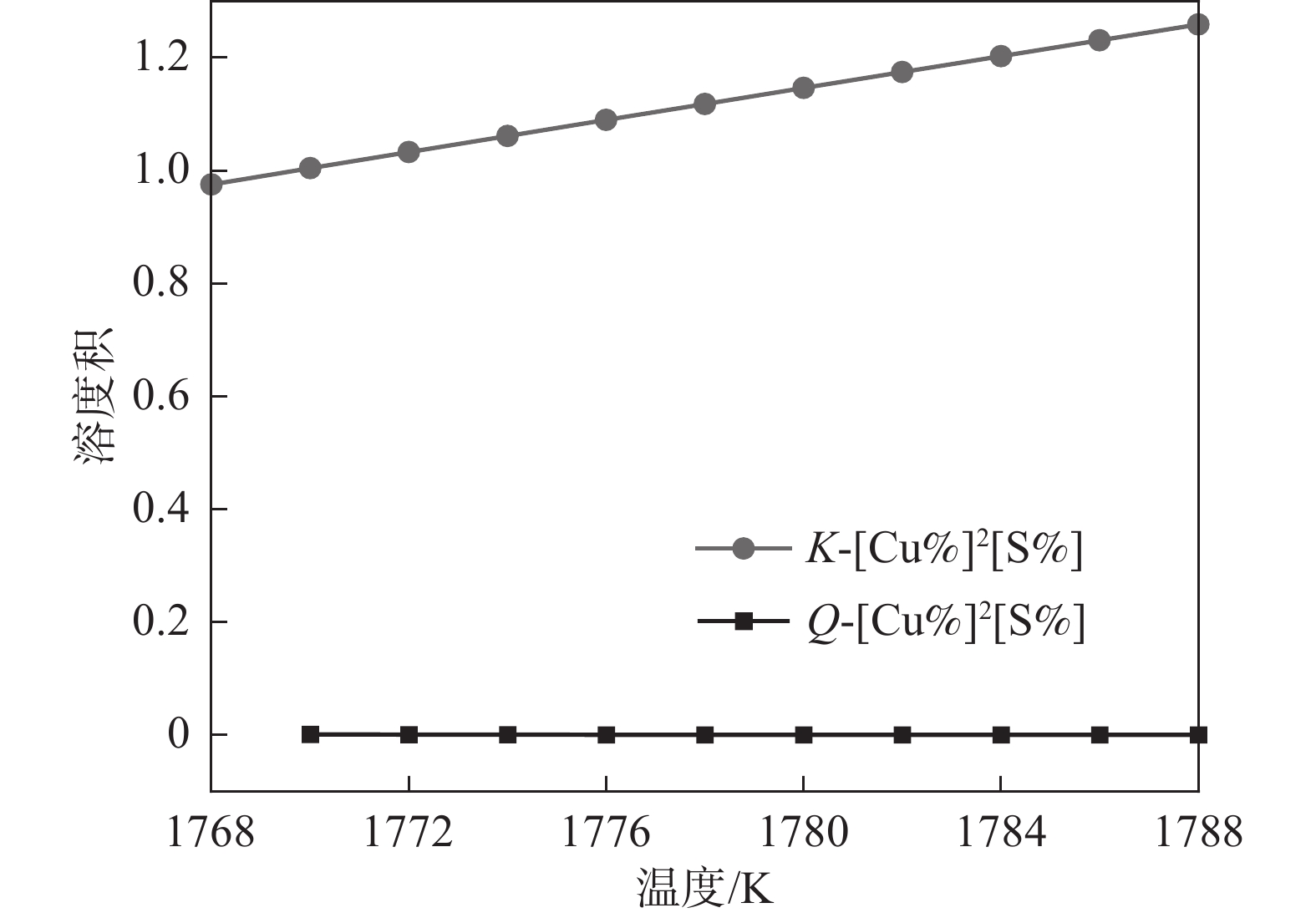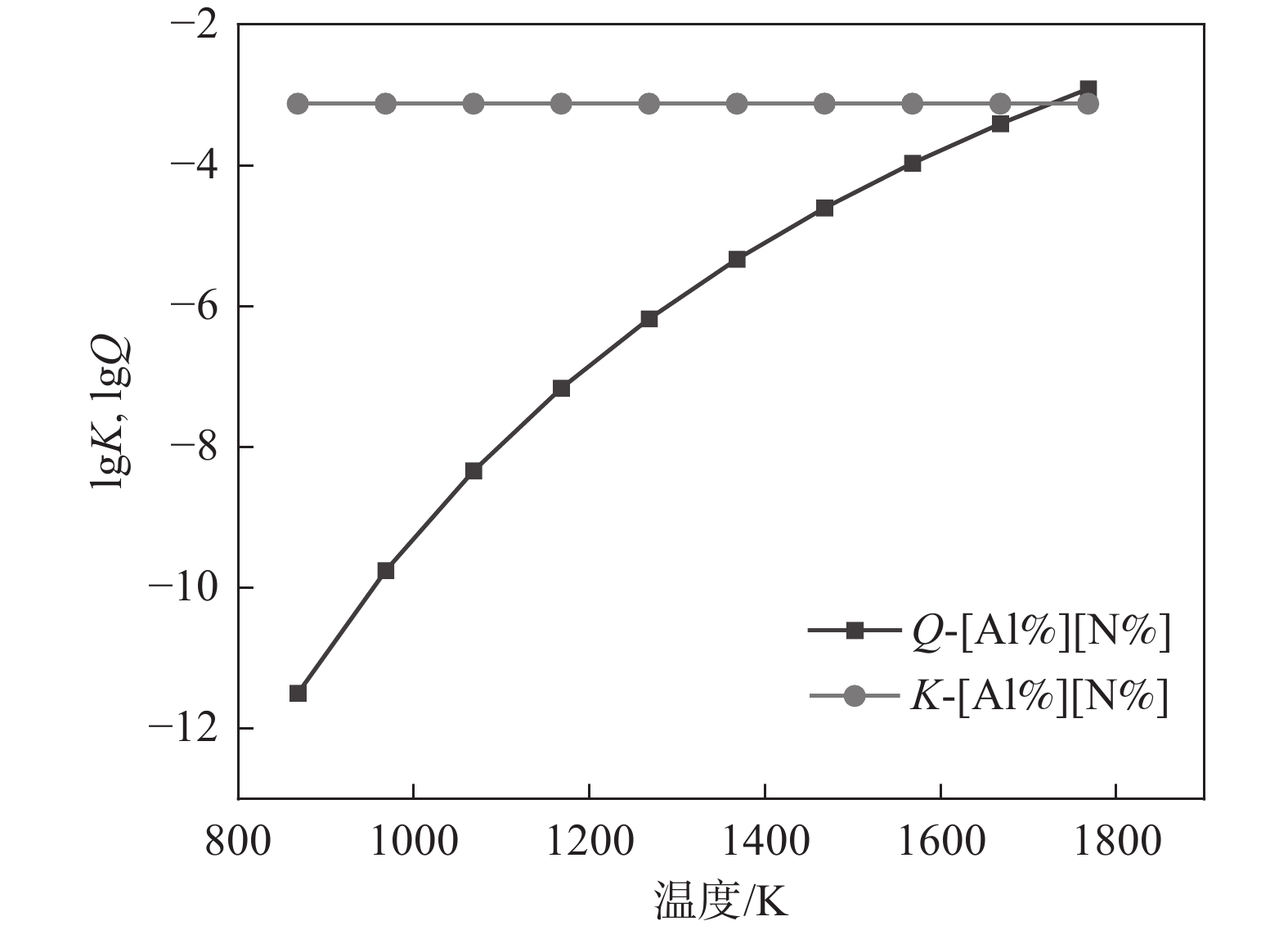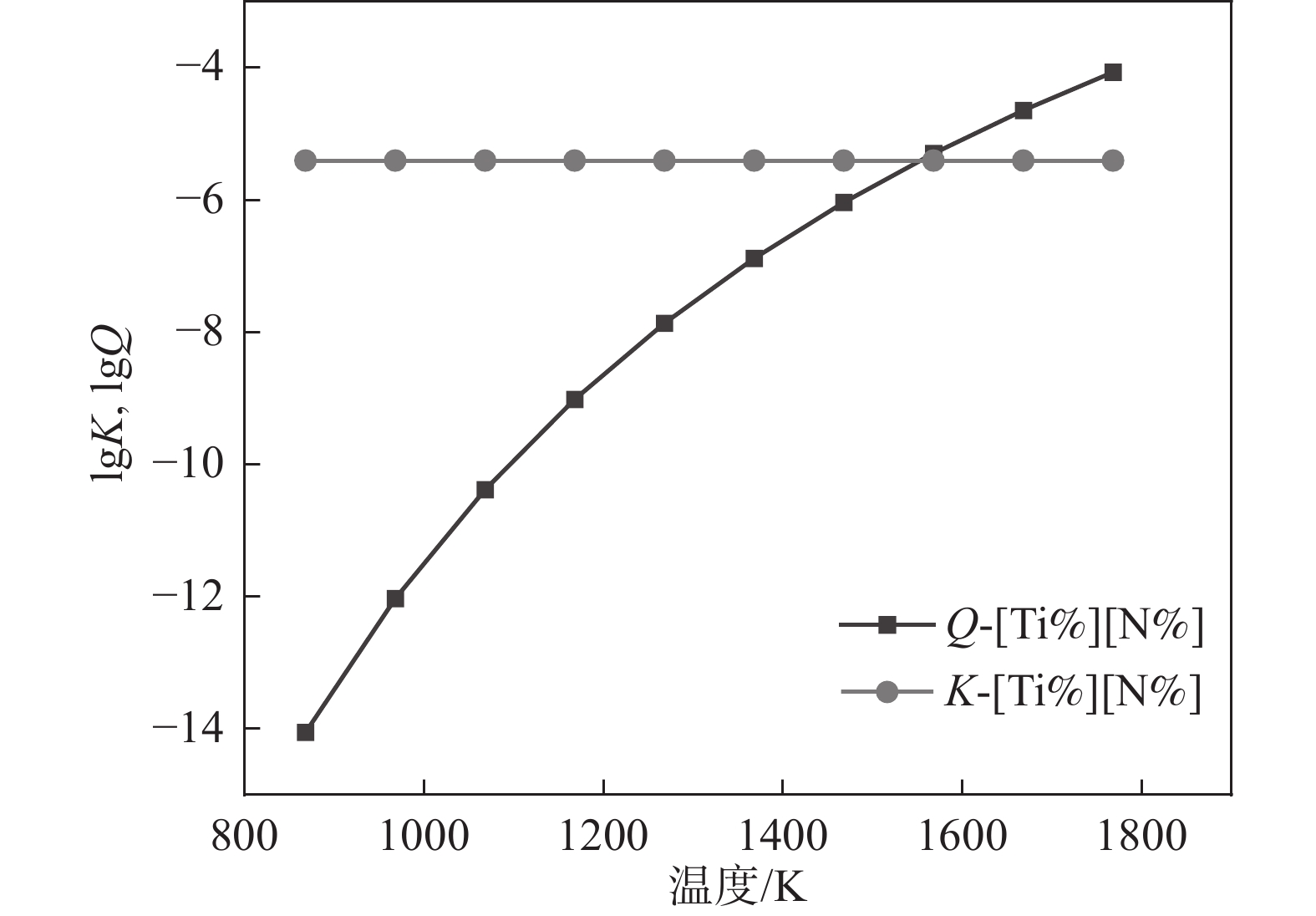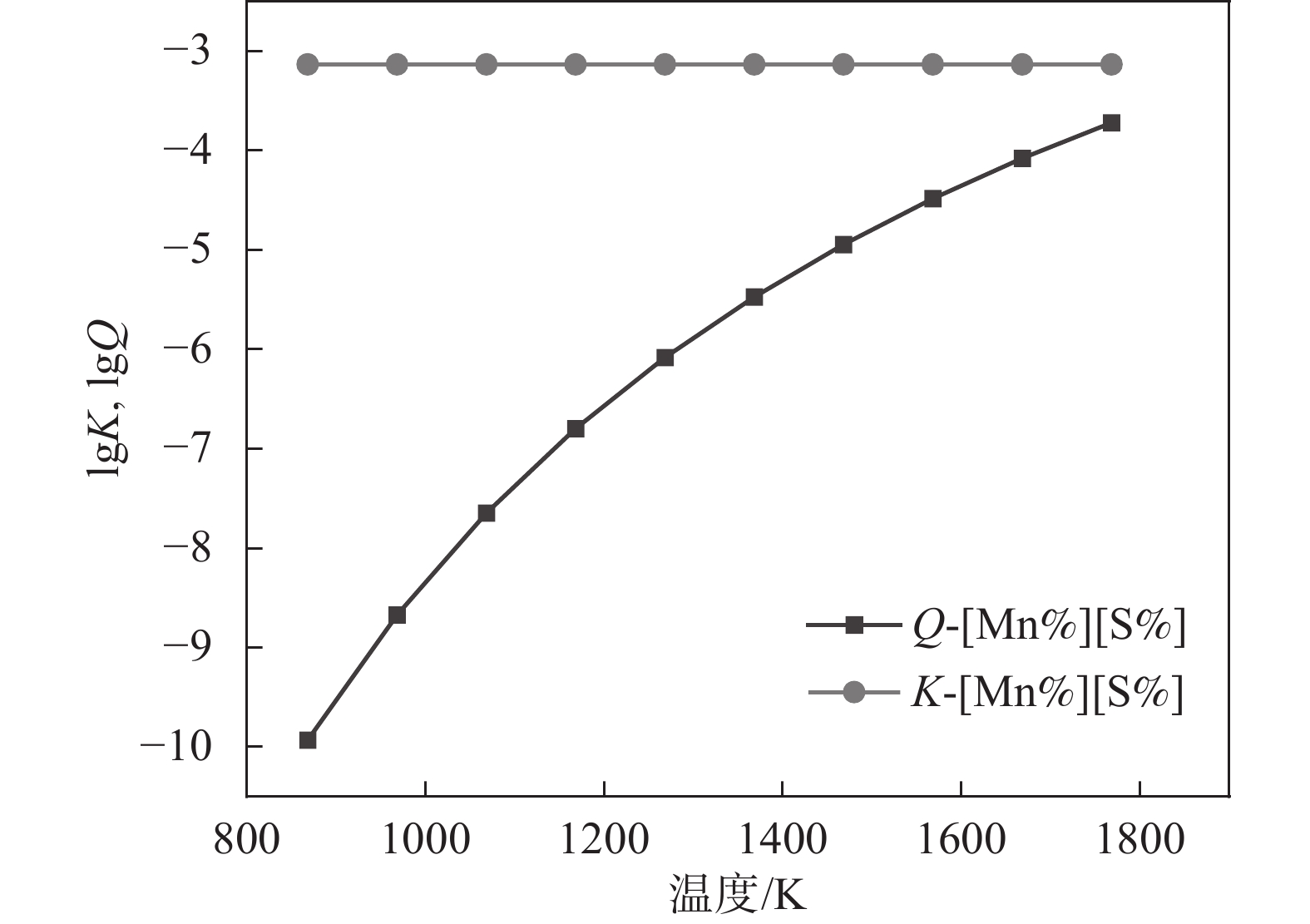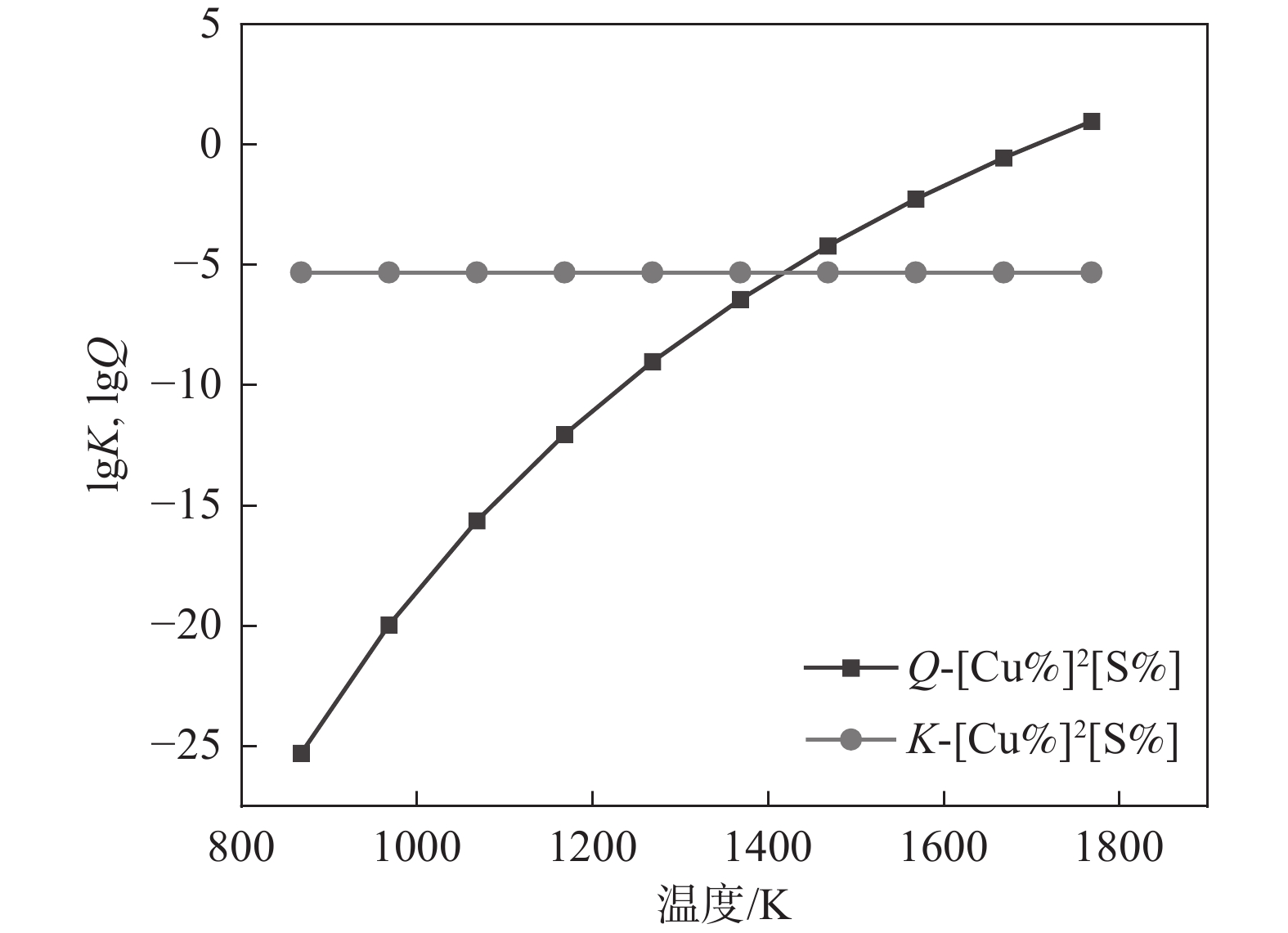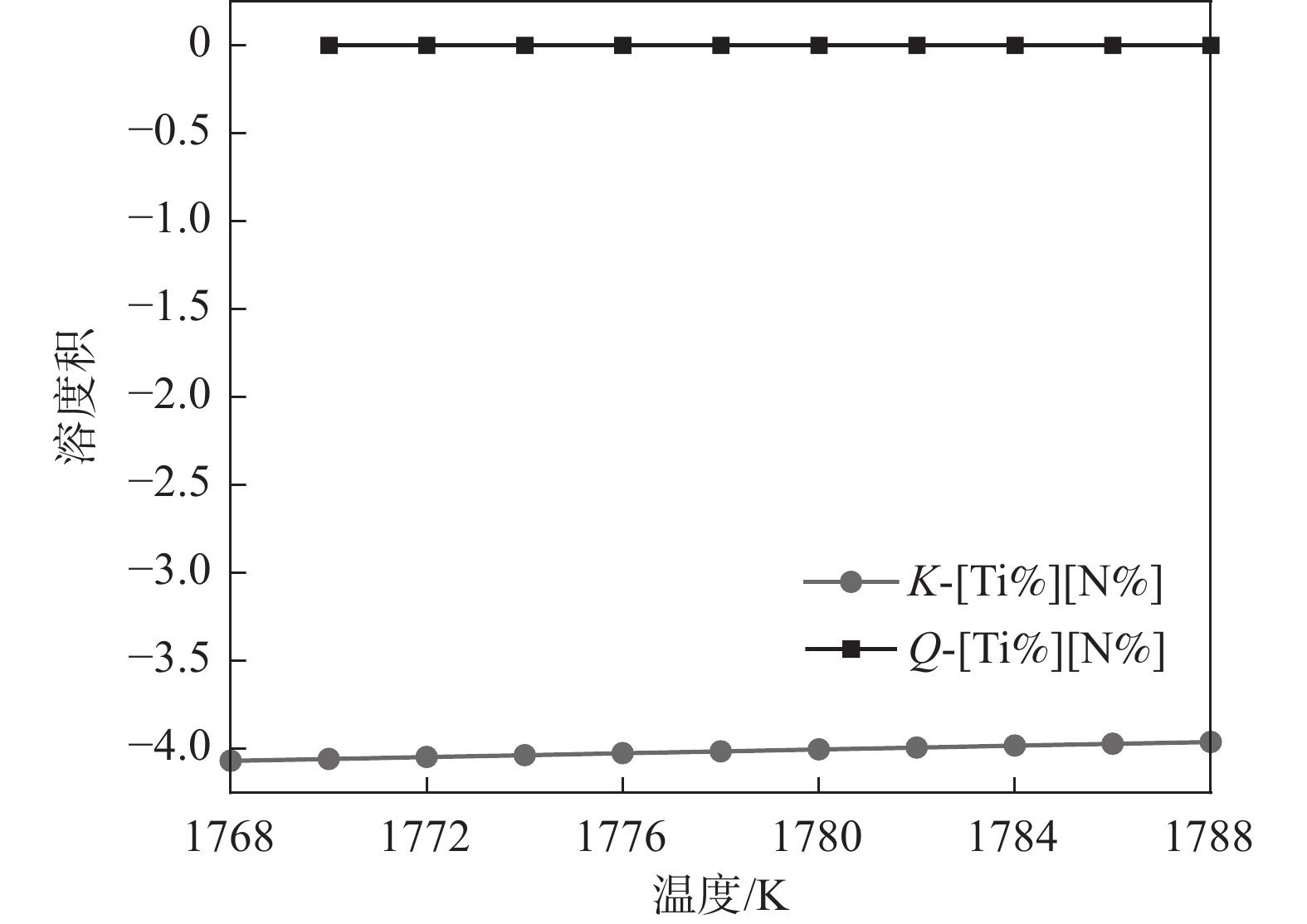Thermodynamic calculation of sulfide and nitride precipitation in high grade non-oriented silicon steel
-
摘要: 通过对高牌号无取向电工钢 50W350硫化物、氮化物的热力学计算,获得了析出物的平衡浓度关系。液相线温度以下,AlN在
1700 ~1788 K温度区间析出,TiN的析出温度区间为1588 ~1788 K,MnS的析出温度区间在1768 ~1788 K范围内,Cu2S的析出温度范围为1420 ~1768 K,并通过实际检测,证实了各温度区间析出物的存在。Abstract: The equilibrium concentration relationship of precipitates was obtained by thermodynamic calculation of sulfide and nitride of the high grade non-oriented electrical steel 50W350. Below the liquidus temperature, AlN precipitates in the range of 1 700-1 788 K, TiN in the range of 1 588-1 788 K, MnS in the range of 1 768-1 788 K, Cu2S in the range of 1 420-1 768 K. The existence of precipitates in each temperature range has been confirmed through detection.-
Key words:
- non-oriented silicon steel /
- liquidus temperature /
- solidus temperature /
- sulfide /
- nitride /
- solubility product
-
0. 引言
无取向硅钢中析出物的粒径为0.1~1 μm时,会导致最终的磁性能降低[1−4]。分析其原因,是百纳米级夹杂物的存在阻碍了磁畴壁(尺寸为100~900 nm)的正常移动[5−7],使得晶粒不能正常长大[8−10],最终降低了无取向硅钢产品的磁性能[11]。Boc I 等人[7]的研究得到了以下结论:夹杂物粒子在0.005~0.5 μm范围和直径>0.5 μm或者<0.005 μm的粒子分别进行比较,结果得出0.005~0.5 μm粒径对磁性能重要得多。
文献[4]介绍了高牌号硅钢的硫化物和氮化物的析出热力学计算,但是由于高端牌号硅钢本身的保密性,即使不同企业同一牌号硅钢成分之间也并不一致,尤其针对Al、Mn等额外添加的合金元素,此外S和N的含量也体现了各个企业炼钢水平的高低,上述成分之间差距均较大。
为此,笔者以国内某厂的高牌号无取向硅钢50W350中的MnS、Cu2S、AlN和TiN为例,针对具体生产单位的高牌号中硫、氮化物等展开热力学分析,从热力学角度研究了无取向硅钢生产过程中析出物的规律。
1. 热力学计算推导
由于热力学计算获得的是平衡浓度积和温度之间的关系,进而可以得到具体硫、氮化物的析出温度,这对现场理论指导有重要意义。
由于MnS、Cu2S、AlN和TiN随着钢水降温过程中溶解度逐渐发生变化,且固液相之间变化趋势不同,因此当实际溶度积(Q)大于平衡溶度积(K)时,意味着析出物开始析出。钢中的金属M(铝、锰等)与非金属X(氮、硫)残余反应生成MX。在反应过程中平衡常数的计算如式(1)所示。
$$ K\mathrm{_{eq}}=\dfrac{a_{\mathrm{M}\mathrm{X}}}{a_{\mathrm{M}}a_{\mathrm{X}}}=\dfrac{1}{f_{\mathrm{M}}\left[\mathrm{\%}\mathrm{M}\right]f_{\mathrm{X}}\left[\mathrm{\%}\mathrm{X}\right]} $$ (1) 式中, [%M]为金属质量百分含量; [%X]为氮、硫的质量百分数;fM为金属元素活度系数;fX为氮、硫的活度系数。
根据MX反应的$ \Delta {G}^{{\theta }} $数据可得:
$$ \mathrm{l}\mathrm{g}{K}_{\mathrm{e}\mathrm{q}}=-\dfrac{\Delta {G}^{{\theta }}}{2.3RT}=B-\dfrac{A}{T} $$ (2) 式(1)取对数,代入式(2)可得式(3):
$$ \mathrm{lg}\left[\mathrm{\%}\mathrm{M}\right]+\mathrm{lg}\left[\mathrm{\%}\mathrm{X}\right]+\mathrm{l}\mathrm{g}{f}_{\mathrm{M}}+\mathrm{l}\mathrm{g}{f}_{\mathrm{X}}=B-\dfrac{A}{T} $$ (3) 式中,B代表$ \dfrac{\Delta S}{2.3 R} $计算得到的具体数值,其中$ \Delta S $为熵变,R为8.314 J/(mol·K); A代表$ \dfrac{\Delta H}{2.3 R} $计算得到的具体数值,其中$ \Delta H $为焓变。
由于钢中有关MnS、Cu2S、AlN和TiN生成反应的$ \mathrm{l}\mathrm{g}{f}_{\mathrm{M}}、\mathrm{l}\mathrm{g}{f}_{\mathrm{X}} $值对式(3)中B值的影响很小,可以将式(3)转换为式(4)。
$$ \mathrm{lg}\left[\mathrm{\%}\mathrm{M}\right]\left[\mathrm{\%}\mathrm{X}\right]=-\dfrac{\Delta {G}^{\theta }}{2.3RT}=B-\dfrac{A}{T} $$ (4) 经过上述公式的推导,可以获得具体的B和A,此外也可获得平衡溶度积K和实际溶度积Q,如表1所示。
当钢水温度降低到两相区时,钢中的溶质元素等元素发生偏析,此时氮、硫的含量及锰、铝元素的含量分别用式(5)(6)计算。
$$ \left[\mathrm{\%}\mathrm{X}\right]=\dfrac{{\left[\mathrm{\%}\mathrm{X}\right]}_{0}}{{f}_{\mathrm{s}}\left({k}_{\mathrm{X}}-1\right)+1} $$ (5) $$ \left[\mathrm{\%}\mathrm{M}\right]={\left[\mathrm{\%}\mathrm{M}\right]}_{0}{(1-{f}_{\mathrm{s}})}^{{k}_{\mathrm{M}}-1} $$ (6) 式中, fs为固相百分率;kM为金属元素M的平衡溶质分配因数;kX为非金属X的平衡溶质分配因数;析出物形成实际的浓度积QMX可表示为[4]:
$$ Q_{\mathrm{MX}}=[\% \mathrm{M}][\% \mathrm{X}]=\frac{[\% \mathrm{M}]_0[\% \mathrm{X}]_0\left(1-f_{\mathrm{s}}\right)^{k_{\mathrm{M}}-1}}{f_{\mathrm{s}}\left(k_{\mathrm{X}}-1\right)+1} $$ (7) 温度T与固相百分率fs的关系如式(8)表示。
$$ {f}_{\mathrm{s}}=\frac{({T}_{\mathrm{F}\mathrm{e}}-{T}_{\mathrm{s}})({T}_{\mathrm{l}}-T)}{({T}_{\mathrm{l}}-{T}_{\mathrm{s}})({T}_{\mathrm{F}\mathrm{e}}-T)} $$ (8) 式中, T为凝固过程中液相温度,K;TFe为纯铁的熔点(1 809 K);TL为液相线温度,K;TS为固相线温度,K。
2. 热力学计算条件
计算钢种为模拟高牌号典型无取向硅钢种50W350,其主要化学成分如表2所示。分别通过FactSage软件Phase Diagram相图计算模块,其在铁硅相图中位置如图1所示,绿色线代表试验钢在相图中的具体位置。表3为各个阶段的平衡溶质分配因数和液相线。
表 2 试验钢的主要化学成分Table 2. Main chemical composition of the tested steel% C Mn Si S P Als N Ti Cu 0.0019 0.32 2.72 0.0023 0.014 0.5016 0.0015 0.0026 0.046 液相线和固相线采用如下公式计算[4]:
$${\begin{split} & {T_{\mathrm{L}}} = 1536 + 273 - \Big\{ [90[\% {\mathrm{C}}] + 6.2[\% {\mathrm{Si}}] + 1.7[\% {\mathrm{Mn}}] + \\ & 28\left[ {\% {\mathrm{P}}} \right] + 40\left[ {\% {\mathrm{S}}} \right] + 2.6[\% {\mathrm{Cu}}] + 2.9[\% {\mathrm{Ni}}] + 1.8[\% {\mathrm{Cr}}] +\\ & 5.1[\% {\mathrm{Al}}]\Big\} \\[-16pt] \end{split}} $$ (9) $$ {\begin{split} &{T_{\mathrm{s}}} = 1536 + 273 - \{ [415.3[\% {\mathrm{C}}] + 12.3[\% {\mathrm{Si}}] +6.8 \\ & [\% {\mathrm{Mn}}] +124.5\left[ {\% P} \right] + 183.9\left[ {\% S} \right] + 1.4[\% {\mathrm{Cu}}] +4.3\\ & [\% {\mathrm{Ni}}] +1.4[\% {\mathrm{Cr}}] + 4.1[\% {\mathrm{Al}}]\}\\[-16pt] \end{split}} $$ (10) 3. 热力学计算结果
3.1 液相计算结果
从表3可以看出,液相线
1788 K,因此本小节计算的结果是温度在1788 K以上的部分。将热力学数据代入式(4)得出AlN、TiN、MnS和Cu2S在钢液中的平衡溶度积。图2~5中为平衡溶度积和实际溶度积取对数。从表1可以看出,平衡溶度积与温度T呈现正相关关系,图2~5中曲线K对此可以作出相关解释。钢中温度从液相线1788 K上升到1 940 K,AlN平衡溶度积K的取值范围为−1.57~−0.91,MnS的平衡溶度积K取值在−0.29~0.11;AlN和MnS的Q和K两条曲线均没有交集,且Q值始终小于K,即AlN和MnS都不可能析出。同理对TiN和Cu2S进行相关分析,两者的Q都小于K,都不能析出。3.2 凝固过程分析
50W350牌号无取向硅钢凝固过程中不存在γ相,这一点从图1中可以看出,因此只需要计算L→α和完全α即可。从表3可以看出,固相线温度为
1768 K,液相线温度为1788 K,由于凝固阶段包含固液相温度区间以及完全α阶段, 即L→α阶段,即1768 ~1788 K和固相线温度以下部分完全α阶段,即小于1768 K。3.2.1 L→α阶段
根据溶度积公式计算,将固液相线代入公式(8),得到固相率$ \mathrm{\mathit{f}}_{\mathrm{s}} $,再将固相率代入公式(7),就可以得到实际平衡浓度积Q。图6~9为相关氮化物、硫化物溶度积曲线。
AlN的溶度积关系如图6所示。可以看出Q和K曲线没有交点,且Q始终能够高于K,这说明实际溶度积高于平衡溶度积,即次过程有AlN析出。此外,从Q的变化趋势也可以知道,液相向固相转换过程中,溶质元素Al和N逐渐增高,因此其溶度积也在逐渐增加,从
1768 K时的0.023增加到1788 K时的0.029。由于Q>K,AlN在此温度范围内可以析出。由图7可知,从
1788 K降温到1770 K,在此过程中Q和K没有交点,但是Q始终大于K,这表明TiN在1788 ~1788 K温度范围内是可以析出的。综上所述,液相线和固相线之间的MnS溶度积关系如图8所示, MnS的Q和K曲线没有交点,但Q始终高于K,即MnS在此温度范围内是可以析出的。
同理,液相线和固相线之间的Cu2S溶度积关系如图9所示,Cu2S的Q和K曲线没有交点,且Q始终低于K值,此种情况下Cu2S不具备析出热力学条件。
3.2.2 完全α阶段
图10~13为高牌号50ZW350无取向硅钢凝固过程到完全α阶段,氮化物和硫化物的析出溶度关系。由图10可知,K和Q曲线相交点的横坐标为
1700 K,即保持Q大于K的温度范围必须是1700 K以上,在此范围内AlN可以从凝固过程中析出。而TiN的Q和K曲线相交点横坐标为1588 K(见图11),也就是1588 K温度范围以上,TiN是能够从凝固过程中析出的。而MnS的Q和K不相交,且Q数值小于K(见图12),即MnS在此温度范围内不可能析出。Cu2S的Q和K曲线相交点的横坐标为1420 K(见图13),且在温度1420 K以上Q大于K时,Cu2S是可以析出的。3.3 实际结果验证
为了证明上述分析的准确性,仅从热轧板取试样,经过电解抛光,并在扫描电镜下观察。图14~17为实际检测到的结果。这也说明了上述分析的可行性。
4. 结论
1)在钢液中即液相线温度以上,AlN、TiN、MnS和Cu2S均不能析出;
2)在凝固过程中即液相线温度以下,AlN在L→α阶段以及固相线以下部分温度段析出,即
1700 ~1788 K温度区间可能析出,TiN在L→α阶段以及固相线以下部分温度段析出,即1588 ~1788 K温度区间析出,MnS仅在L→α阶段,即1768 ~1788 K温度区间析出,Cu2S在固相线以下部分温度段,即1420 ~1768 K温度区间时析出。 -
化合物 K Q 相 AlN 6.334- 14069 /T[%Al][%N] 液相 MnS 4.63- 8750 /T[%Mn][%S] 液相 AlN 5.37- 14640 /T[%Al][%N] δ相 AlN 2.27- 10590 /T[%Mn][%S] δ相 Cu2S 26.31- 44791 /T[%Cu]2[%S] 液相+δ相 TiN 5.56- 17025 /T[%Ti][%N] 液相+δ相 表 2 试验钢的主要化学成分
Table 2. Main chemical composition of the tested steel
% C Mn Si S P Als N Ti Cu 0.0019 0.32 2.72 0.0023 0.014 0.5016 0.0015 0.0026 0.046 -
[1] Li Wenquan, Gao Zhenyu, Luo Li, et al. Elementary analysis on influence of inclusion on magnetic performance of electric steel[J]. Angang Technology, 2004 (1): 18-21. (李文权, 高振宇, 罗理, 等. 夹杂物对电工钢磁性能影响的初步分析[J]. 鞍钢技术, 2004(1): 18-21.Li Wenquan, Gao Zhenyu, Luo Li, et al. Elementary analysis on influence of inclusion on magnetic performance of electric steel[J]. Angang Technology, 2004 (1): 18-21. [2] Wu Yuan. Characteration of inclusion/precipitate and the effect of sulfide on the microstructure of the high-grade non-oriented silicon steel[D].Shanghai: Shanghai University, 2017. (吴媛. 高牌号无取向硅钢中夹杂物/析出物的表征及硫化物对组织影响的研究[D]. 上海:上海大学,2017.Wu Yuan. Characteration of inclusion/precipitate and the effect of sulfide on the microstructure of the high-grade non-oriented silicon steel[D].Shanghai: Shanghai University, 2017. [3] Wu Derun, Tang Hongle, Li Yuhua, et al. Effects of ladle top slag modification treatment on inclusion and electromagnetic properties of non-oriented electrical steels[J]. Electrical Materials, 2016(1):5-16. (吴德润, 唐洪乐, 李玉华, 等. 钢包顶渣改性对无取向电工钢夹杂物和磁性能的影响[J]. 电工材料, 2016(1):5-16.Wu Derun, Tang Hongle, Li Yuhua, et al. Effects of ladle top slag modification treatment on inclusion and electromagnetic properties of non-oriented electrical steels[J]. Electrical Materials, 2016(1): 5-16. [4] Wu Shuang, Fan Lifeng, Mao Yibiao, et al. Thermodynamics of sulfide and nitride precipitation in high-grade non-oriented electrical steel[J]. Metallurgical Collections, 2009(2):3-12. (吴爽, 樊立峰, 毛一标, 等. 高牌号无取向电工钢中硫化物、氮化物析出的热力学分析[J]. 冶金丛刊, 2009(2):3-12.Wu Shuang, Fan Lifeng, Mao Yibiao, et al. Thermodynamics of sulfide and nitride precipitation in high-grade non-oriented electrical steel[J]. Metallurgical Collections, 2009(2): 3-12. [5] Li Daizhong. Non-metallic inclusions in steel[M]. Beijing:Science Press, 1983. (李代钟. 钢中的非金属夹杂物[M]. 北京:科学出版社, 1983.Li Daizhong. Non-metallic inclusions in steel[M]. Beijing:Science Press, 1983. [6] He Zhongzhi, Zhao Yu, Luo Haiwen. Electrical Steel[M].Beijing:Metallurgical Industry Press,2012. (何忠治, 赵宇, 罗海文. 电工钢[M]. 北京:冶金工业出版社,2012.He Zhongzhi, Zhao Yu, Luo Haiwen. Electrical Steel[M].Beijing:Metallurgical Industry Press, 2012. [7] Boc I. Analysis of inclusion in cold rolled Si-Fe strips[J]. Joumal of Magnetism and Magnetic Materials, 1990,83:38l-383. [8] Darja Steiner Petrovič, Boštjan Arh, Franc Tehovnic, et al. Magnesium non-metallic inclusions in non-oriented electrical steel sheets[J]. ISIJ International, 2011,51(12):2069-2075. doi: 10.2355/isijinternational.51.2069 [9] Wu Shaojie, Wan Yong, Chen Weiqing, et al. Examination and study on cleanliness of non-oriented silicon steel XG800WR in 210 t BOF-RH-CC steelmaking process[J]. Special Steel, 2011,32(5):56-59. (吴绍杰, 万勇, 陈伟庆, 等. 210 t BOF-RH-CC炼钢流程无取向硅钢XG800WR洁净度的试验研究[J]. 特殊钢, 2011,32(5):56-59. doi: 10.3969/j.issn.1003-8620.2011.05.017Wu Shaojie, Wan Yong, Chen Weiqing, et al. Examination and study on cleanliness of non-oriented silicon steel XG800WR in 210 t BOF-RH-CC steelmaking process[J]. Special Steel, 2011, 32(5): 56-59. doi: 10.3969/j.issn.1003-8620.2011.05.017 [10] Peng Qichun, Qiu Lei, Zou Jian, et al. Evolution of inclusions in non-oriented silicon steel W800 in 210 t during production process[J]. Iron and Steel, 2015,50(8):34-38. (彭其春, 邱雷, 邹健, 等. 无取向硅钢W800生产过程中夹杂物演变规律[J]. 钢铁, 2015,50(8):34-38.Peng Qichun, Qiu Lei, Zou Jian, et al. Evolution of inclusions in non-oriented silicon steel W800 in 210 t during production process[J]. Iron and Steel, 2015, 50(8): 34-38. [11] Lü Xuejun, Zhang Feng, Wang Bo, et al. Effects of inclusions on magnetic properties of non-oriented silicon steel[J]. Special Steel, 2012(4):22-25. (吕学钧, 张峰, 王波, 等. 夹杂物对无取向硅钢磁性能的影响[J]. 特殊钢, 2012(4):22-25. doi: 10.3969/j.issn.1003-8620.2012.04.006Lü Xuejun, Zhang Feng, Wang Bo, et al. Effects of inclusions on magnetic properties of non-oriented silicon steel[J]. Special Steel, 2012(4): 22-25. doi: 10.3969/j.issn.1003-8620.2012.04.006 -





 下载:
下载:

















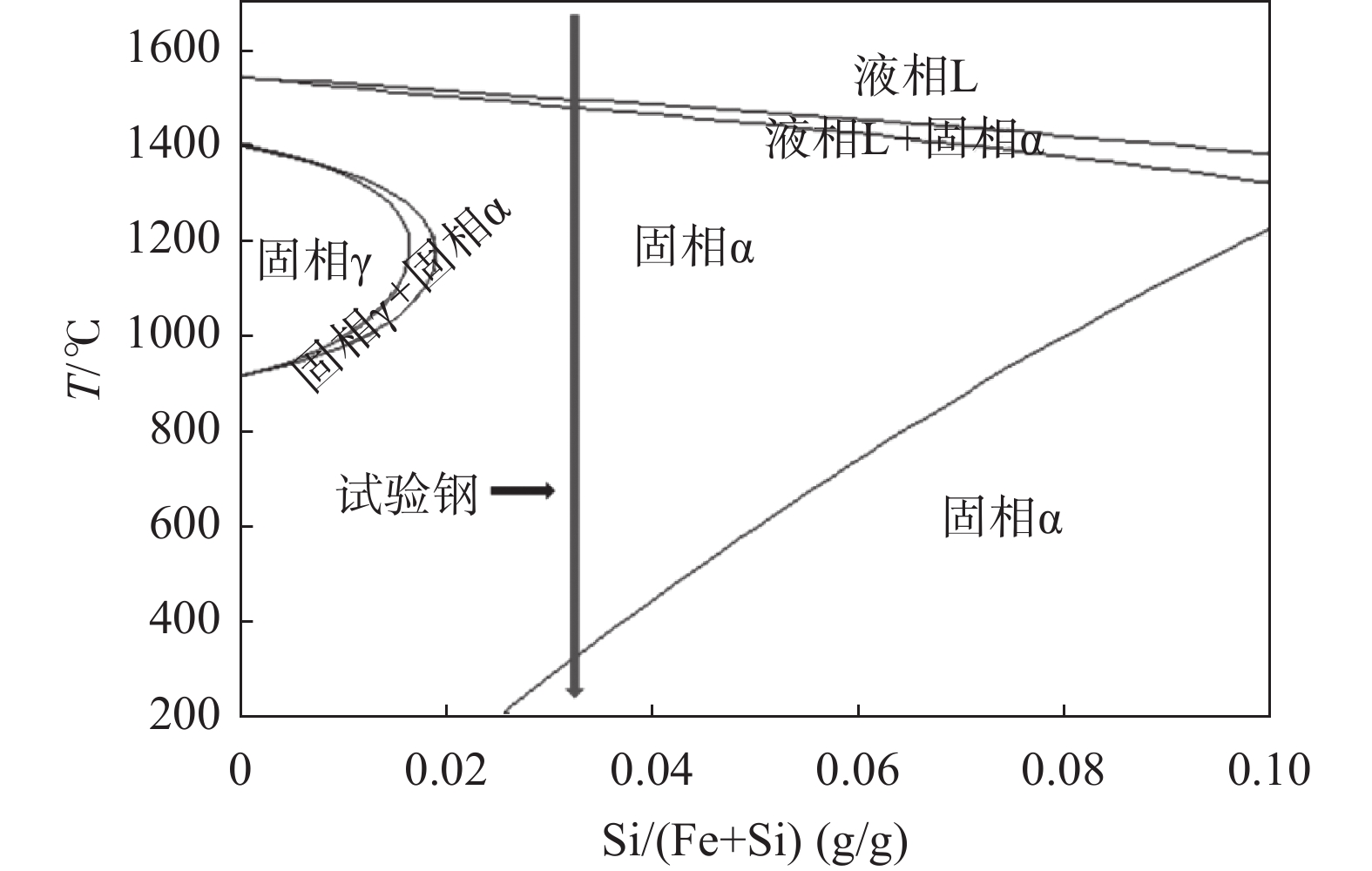
 下载:
下载:
